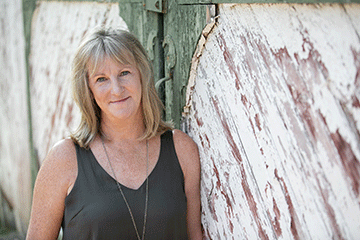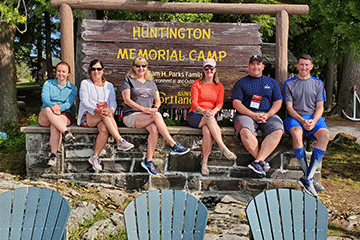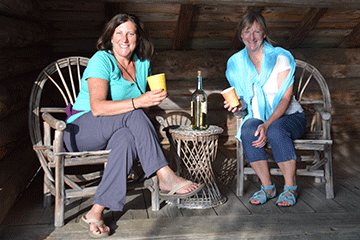
12/07/2021
Sheila Myers ’85 didn’t set out to become an expert on the family of one of the Gilded Age’s most noted tycoons, Dr. Thomas C. Durant.
But she did. By serendipity closely connected with SUNY Cortland, Myers now is a source of information and commentary about this late 19th century American respected enough to be interviewed by the History Channel and invited to lecture professional historians on the topic. The Cayuga Community College science instructor and administrator of the school’s honors program is living proof that, regardless of your major, a SUNY Cortland education helps you achieve whatever varied goals you set your sights on.
Myers’ background isn’t history. She earned a bachelor’s degree in political science from SUNY Cortland and a master’s degree in environmental science from SUNY College of Environmental Science and Forestry in 1992.
And yet:
- Myers on Oct. 10 was a featured guest on the “Race for the Railroad” episode in the History Channel’s “Engineering That Built the World” series. She was interviewed about Durant, the family patriarch and head of the Union Pacific Railroad. He was a driving force in building the transcontinental overland train route, which transformed America’s settlement and development in the west. Durant became a main character in the AMC drama series “Hell on Wheels,” set during the time he pushed to connect the country’s two coasts.
- She wrote a trilogy of novels about the Durant family that includes Imaginary Brightness (CreateSpace Independent Publishing Platform, 2015), Castles in the Air (Zahigkeit Press, 2016), and The Night is Done (CreateSpace Independent Publishing Platform, 2017). The final, stand-alone volume won the 2017 Adirondack Center for Writing Literary Award for Best Book of Fiction in 2017 and received a Kirkus Star Review.
- Myers has presented her research on the Durants at the Sagamore Institute’s Gilded Age series, the New York State Association of Public Historians, the Researching New York Conference and other venues.
- In 2019, she lectured as part of the “Forever Wild: The Adirondacks in the Gilded Age and Progressive Era, a National Endowment for the Humanities (NEH) ‘Landmarks in American History and Culture’" workshop hosted in Raquette Lake by SUNY Cortland’s History Department.
“My books do have a strong theme of the natural world,” Myers said. “That’s one reason I was interested in the Durants and their Adirondack land holdings and the time period, because of all the changes that were happening in the Adirondack Park at the time.”
Her path to becoming the go-to source about the Durants began during a summer 2012 stay with several other Red Dragon alumni at the very remote Kirby Camp of SUNY Cortland’s William H. Parks Family Center for Environmental and Outdoor Education, Camp Huntington, in Raquette Lake, N.Y.

Campers can only get there by boat. Kirby Camp is a favorite haunt of students learning how to live in the outdoors as well as a pleasant, short hike for visitors from the main buildings of Camp Huntington.
But the tiny cottage on the shore of Raquette Lake is imbued with history about the son of Thomas, William West Durant, who designed and constructed what is considered to be the original rustic style Adirondack Great Camp, now owned by SUNY Cortland.
“I started writing this trilogy about the Durants because I stayed at Camp Kirby with alums, and I heard the story about (Thomas’ son) William West Durant and his supposed mistress,” Myers said. “I thought I was going to write a love story about that family."
She had already written a love story that was set in the Finger Lakes, Ephemeral Summer (CreateSpace Independent Publishing Platform, 2014), she said.
Joining Myers for that long weekend at remote Kirby Camp was her husband, Joseph Judge ’84, their friend Karen Streiff Conlon ’85, and her husband, Jack. The result from that short vacation was three novels offering her semi-fictional Durant family saga.
The four had heard the local folklore that Thomas’ son William West Durant had used Kirby Camp to rendezvous in secret with his purported mistress Minnie Kirby (niece of the camp owner Cornelia Kirby), destroying his marriage on the road to the family’s eventual financial ruin.
“I really didn’t know anything about the Durants at the time,” Myers said. “And I got into researching the Durants and found out there was a lot more to the story and the history and I just kind of went down this rabbit hole of research on the family.”
She had visited Camp Huntington before, not as a student, but when she formerly worked for Cornell Cooperative Extension.
“But that was really my first time at Camp Kirby,” Myers said. “Since then, I’ve stayed there a number of times and I actually wrote the second book in the trilogy at Camp Kirby. I stayed there alone for about four or five nights. That was fun, I got a lot done.”
What’s well known about the Durants is that after their patriarch lost his shirt over his railroad venture, the family still owned half a million acres in the Adirondack Wilderness, including what is now Camp Huntington. William West Durant, a pioneer of the Great Camp style of architecture, built Camp Huntington and other Great Camps in the Adirondacks.
“The hardest part for me was finding out information about his sister, Ella, who was the one who sued William for her inheritance,” Myers said. “Because (William) squandered all the money and lost all the Durant family land in the Adirondacks. I did find a collection of letters about her at the Syracuse University archives.”
She also viewed original family diaries at the Adirondack Museum and William West Durant’s letters the Library of Congress. She also credits biographer Craig Gilborn, who donated his research on the family to the Winterthur Museum, Garden and Library in Winterthur, Delaware. Her poring over correspondence unearthed details such as the wrecked friendship between the Kirby Camp owner Cornelia of Saratoga Springs, N.Y., and William’s wife, Janet, who borrowed $15,000 from her companion in the midst of the divorce. Cornelia, in turn, sued her friend to get her money back.

Myers took an online screenwriting course and used it to write the screenplay for an unproduced television pilot episode and a series outline about the Durant family, before becoming aware of the “Hell on Wheels” portrayal of some characters.
Myers also blogged about her research for the trilogy because she knew it would interest people.
“This summer, out of the blue, I got a call from somebody from The History Channel,” Myers said. “I think maybe they found me because I had been blogging about it.
“I went to New York City and interviewed for about two hours and spoke about Thomas Durant and his motivation to build the Transcontinental Railroad (to make a lot of money). Writing these books has just turned into this huge thing I never expected to happen. I went from thinking I’d write a love story to becoming an expert on the Durants and appearing on The History Channel years later.”
She has a fifth novel to be published next spring by Black Rose Writing that is set in the Great Smoky Mountains. As she did for her books situated in the Finger Lakes and the Adirondacks, she’s spent a lot of time there, unearthing information about Great Depression-era families displaced for the sake of the national park’s creation.
Her works of fiction set in the outdoors have earned her a small but steady following, including among some Alpha Sigma Phi sisters.
“I think that there’s such a rich history in the Adirondacks and the Durants have been part of the Gilded Age history in the region,” Myers said. “There’s a lot of folklore about that family and it just generates a lot of interest in people to learn about them.”